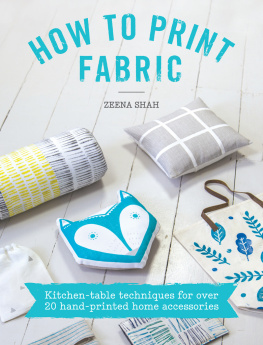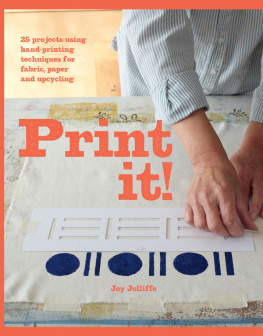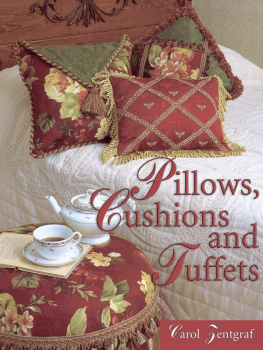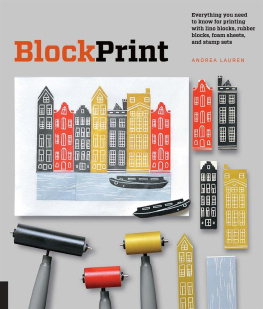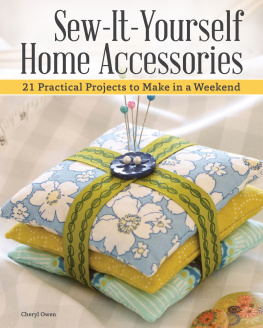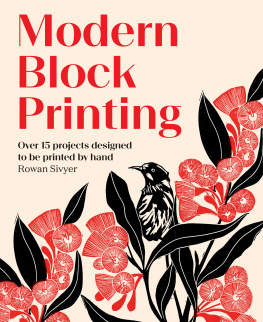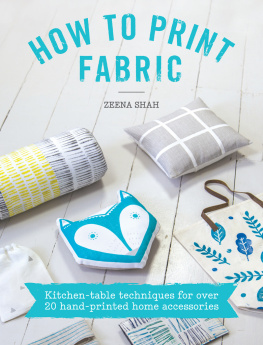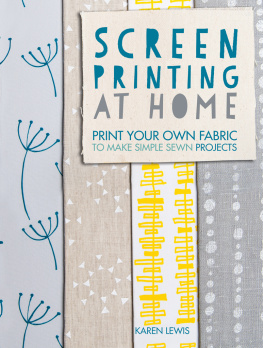Contents
Guide
HOW TO PRINT
FABRIC
ZEENA SHAH

www.stitchcraftcreate.co.uk
FOREWORD BY KIRSTIE ALLSOPP
I first met Zeena on the set of my TV series Kirsties Vintage Home, where I set up my own vintage workshop on Londons Portobello road crammed with a wide range of skilled designer makers and plenty of handmade and homespun style. Zeena shared her printmaking expertise with me to create a beautiful lino printed blind for the series and her sewing know-how to upcycle vintage fabrics into adorable novelty pillows to accessorise your home with. It is a joy to see her now sharing her knowledge and printmaking skills in this beautiful book.
This book is full of brilliant and fun ideas with 20 exciting and original printmaking techniques that will have you addicted to printing fabrics with all manner of tools; from chopsticks and pencil ends to a lint roller. Zeena shows you how to print and sew some lovely projects using objects that you can find in your home and craft on your kitchen table top with very minimal and inexpensive equipment. You can even screen print with an embroidery hoop!
This book is the perfect companion for the beginner crafter, then advance your skills throughout the book building up to more complex makes. I couldnt think of a better way to spend an afternoon!

CONTENTS
INTRODUCTION
For as long as I can remember I have always loved to draw, and I was very much encouraged by my mum to endlessly craft and create things when I was younger. She would buy me and my sisters every 90s craft kit you can think of basket weaving, cross stitching and pompom making, to name a few, and crafting has become more and more of an addiction ever since.
I first fell in love with print design when I was at art school, many moons ago now. Id actually never thought in detail about the fabric printing process itself before this time, but from the moment I started experimenting with mark making, printing onto fabric and designing patterns, I knew I had found my thing!
Often in my printing classes or when Im out running a stand at a lifestyle event I encounter lovely folk who really are terrified of printing they are incredibly keen, but theyre nervous to try it out on their own. So I want this book to bring printing onto fabric to everyone, especially to those at home when I first left art school and set up my own silk screen printed homeware collection I was printing on the kitchen table and washing out my screens in the bathtub!
Here Im going to demonstrate that you really dont need expensive or high-tech equipment to create a collection of beautiful print designs for fabric. Ive therefore chosen printing techniques that youll be able to master from your kitchen table, using a selection of minimal supplies that youre likely to find at the bottom of your recycling box. And for each printing technique I have also included a simple sewing project, so you can make your printed fabric into a beautiful item for your home or as a gift.
By the end of the book I hope to have inspired you to print and sew an assortment of lovely things for your home that you can proudly say youve made yourself when friends come over for dinner.
MARK MAKING
Mark making is a term that describes the process of using a tool to make a mark onto your printing surface, and this is one of the most exciting and experimental aspects of being a printmaker. There are no restrictions on what tools you can use if you can insert an item into your fabric ink then press, roll or dab it onto your fabric to create an interesting mark, then you can and are printing with it!
Throughout this book I will guide you through a variety of techniques for mark making onto fabric. Relief printing is one technique, and describes the process of either carving into an object to create a varied printing surface, or creating a raised printing surface around an object as a block for printing. In this book well use anything from the elastic bands, string, cardboard and foam that you have around your home, to the more well-known soft rubber lino block material, to create original stamps for printmaking. Relief printing is a completely unique process, and it is perfect for the print design projects that follow, as well as for beginners who are getting to grips with the printing process itself.
I will also introduce you to stencilling as a process for mark making onto fabric. Different from the relief printing process, this method is a resist technique and uses stencils to block ink from the fabric itself. Ink is then applied directly across the fabric and the stencils are removed to reveal a print design. Ill show you how to create simple paper and tape stencils for stunning designs on your printed fabric.
SCREEN PRINTING
Screen printing is a completely addictive process, and is what first hooked me into the world of textile design. In this book Ill guide you through different techniques for creating simple and more complex screen printed designs for fabric.
The term screen printing itself describes the process of pushing ink through a woven mesh onto a printable surface. As the mesh pulls away from the surface it leaves behind an even layer of ink with a beautifully clear, crisp and unique finish that you wouldnt be able to achieve in any other way. The ink is pushed through the mesh using a rubber-ended tool known as a squeegee, and a stencil is used to block areas of the mesh to create a pattern.
All you need to practise this process is a screen, a squeegee and some screen printing ink. When choosing your screen I would recommend investing in a mesh screen with an aluminium frame, as it will last longer and it is far more lightweight than a traditional wooden framed screen. Squeegees are often the most expensive tool, but you can use a window cleaners plastic squeegee to try out the process before you commit to buying one!
In this book I will take you through a range of screen printing techniques to create inexpensive stencils for simple one-off designs using freezer paper, masking tape and an embroidery hoop. For more complex designs, Ill also introduce you to the permanent stencil making process (see ), which involves coating your screen mesh with a light-sensitive emulsion that will then be burned with your design.
By the end of this project youll see its not as complicated as you may have thought, and youll have caught the printing bug!

INKS AND DYES
The choices for fabric printing inks are vast, and your own choice simply depends on what finish you want to achieve with your chosen printing technique.
I like to print with fabric screen printing inks that are slightly translucent to achieve a softer, more delicate finish. To create your own, mix acrylic paint and a fabric medium to thin the ink enough for printing this is a method that provides endless colour options, but you can buy ready-mixed colours too.
These water-based screen printing inks work well on lighter coloured fabrics, but they arent so good on darker fabrics where the colour beneath tends to show through. Primarily water-based and environmentally safe, fabric screen printing inks are easy to wash out of your printing equipment. They are also versatile enough to be used for both screen printing and for some of the mark making techniques in this book that dont require a heavier finish.

